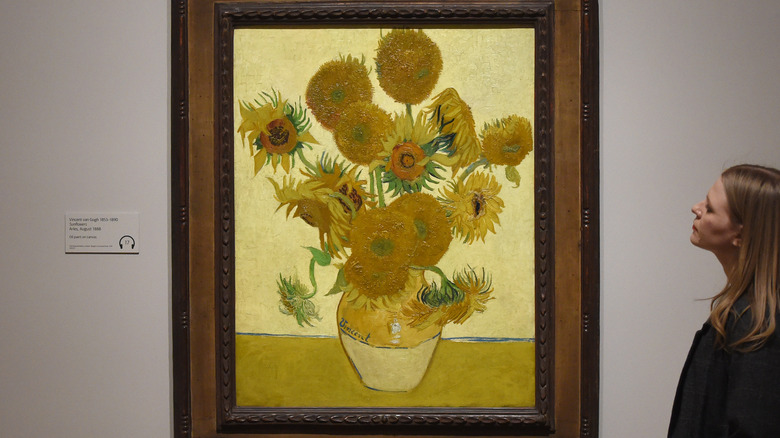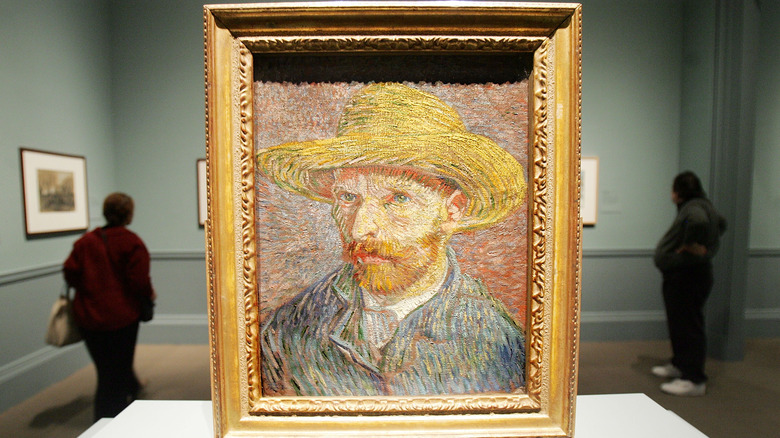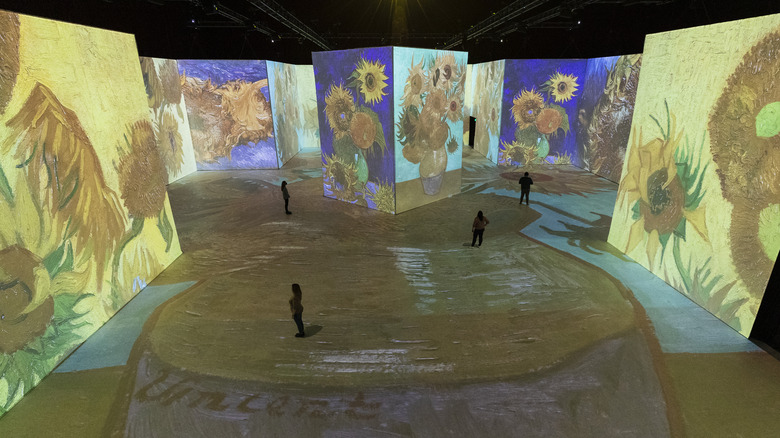Why Van Gogh's Sunflower Paintings Were So Important To Him
Few artists in history have garnered the acclaim that Vincent van Gogh did, though most of it not until after his death. As Britannica explains, van Gogh did not achieve that much recognition during his own lifetime, though today he's considered one of the most influential and valued artists in history. Tragically, van Gogh's life was plagued with both poverty and depression, often going hand in hand. Only one of his paintings was ever sold during his lifetime, and his works were largely ignored for a great period of time. Van Gogh tragically committed suicide from gunshot wound and died on July 29, 1890. He was only 37.
Today, many of van Gogh's works are enjoyed by millions worldwide, though not everyone is a fan. As The New York Times says, climate protesters of the group Just Stop Oil occupied the National Gallery in London at 11 a.m. on October 14. Their goal was to protest the oil and gas industry, which ended with them throwing tomato soup at one of van Gogh's "Sunflowers" paintings, which fortunately was covered by a protective glazing. But what makes van Gogh's "Sunflowers" so valuable? And why did van Gogh have a fascination with sunflowers to begin with?
How van Gogh used color
The first and most immediate aspect of van Gogh's sunflower paintings is their incredibly bold use of color. The yellows and browns seem to pop out to the viewer, creating a mesmerizing display of the flowers that only a master painter could ever capture. As Britannica explains, van Gogh is considered a post-Impressionist painter, an artistic movement which gained traction in the late 19th and early 20th centuries. This collective of mostly French artists — Paul Gauguin and Henri de Toulouse-Lautrec among them — shied away from objective realism, instead opting to depict reality in accord with how it felt. This often lent itself to fantastically lurid subject depictions, vivid colors and dynamic form.
According to Dopely Colors, part of what makes van Gogh's paintings so unique is how he used color. He used a variety of different tones, both dark and light, such as yellow ocher, Prussian blue, zinc white, emerald green, and so on, all based off whatever his mood was at the time. Mood was an essential part of van Gogh's artistic expression. It's also why color symbolism is key to his works, like the yellow in "Sunflowers."
Van Gogh's sunflower paintings were his way of expressing happiness and gratitude
Van Gogh's sunflower paintings are some of his most famous and beloved. As the National Gallery explains, sunflowers held a very special place for van Gogh. He had made multiple paintings of sunflowers throughout his life, with his 1888 painting "Sunflowers" being his most well-known. The color yellow represented happiness for him in an otherwise dark and dreary life. In many ways, these flowers were his way of navigating that gloom. One immediately noticeable thing about the paintings is, like van Gogh's other art, they aren't fully representational or realistic. They conveyed something stronger and more important to van Gogh: emotion.
As Artsy says, his 11 sunflower paintings became emblematic of how van Gogh saw the countryside. He had referenced sunflowers throughout the numerous letters he wrote during his life, as when he told his sister that his art was "almost a cry of anguish while symbolizing gratitude in the rustic sunflower." The sunflower gained enormous importance for the artist after he stayed in an asylum. To him, rural life and flowers were among the very few bright spots in his troubled life. Van Gogh may have forever changed how the world sees sunflowers, and for that, everyone can be eternally thankful.


